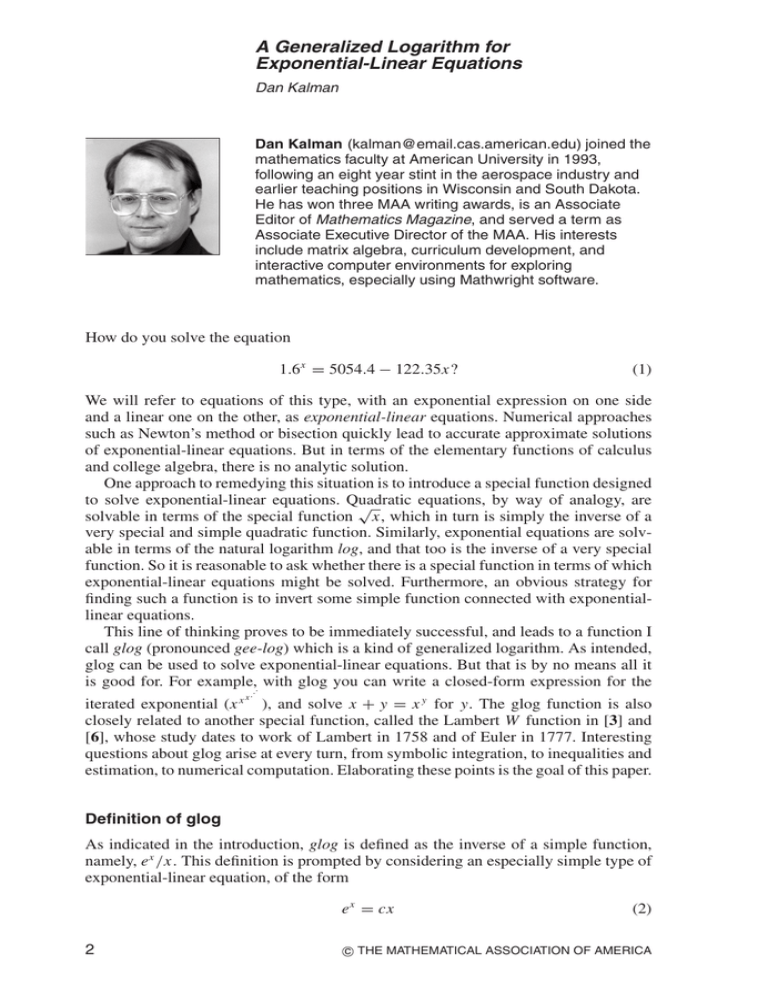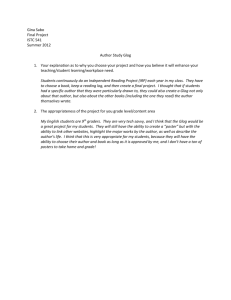A Generalized Logarithm for Exponential
advertisement

A Generalized Logarithm for Exponential-Linear Equations Dan Kalman Dan Kalman (kalman@email.cas.american.edu) joined the mathematics faculty at American University in 1993, following an eight year stint in the aerospace industry and earlier teaching positions in Wisconsin and South Dakota. He has won three MAA writing awards, is an Associate Editor of Mathematics Magazine, and served a term as Associate Executive Director of the MAA. His interests include matrix algebra, curriculum development, and interactive computer environments for exploring mathematics, especially using Mathwright software. How do you solve the equation 1.6x = 5054.4 − 122.35x? (1) We will refer to equations of this type, with an exponential expression on one side and a linear one on the other, as exponential-linear equations. Numerical approaches such as Newton’s method or bisection quickly lead to accurate approximate solutions of exponential-linear equations. But in terms of the elementary functions of calculus and college algebra, there is no analytic solution. One approach to remedying this situation is to introduce a special function designed to solve exponential-linear equations. Quadratic equations, by way of analogy, are √ solvable in terms of the special function x, which in turn is simply the inverse of a very special and simple quadratic function. Similarly, exponential equations are solvable in terms of the natural logarithm log, and that too is the inverse of a very special function. So it is reasonable to ask whether there is a special function in terms of which exponential-linear equations might be solved. Furthermore, an obvious strategy for finding such a function is to invert some simple function connected with exponentiallinear equations. This line of thinking proves to be immediately successful, and leads to a function I call glog (pronounced gee-log) which is a kind of generalized logarithm. As intended, glog can be used to solve exponential-linear equations. But that is by no means all it is good for. For example,. with glog you can write a closed-form expression for the . x. iterated exponential (x x ), and solve x + y = x y for y. The glog function is also closely related to another special function, called the Lambert W function in [3] and [6], whose study dates to work of Lambert in 1758 and of Euler in 1777. Interesting questions about glog arise at every turn, from symbolic integration, to inequalities and estimation, to numerical computation. Elaborating these points is the goal of this paper. Definition of glog As indicated in the introduction, glog is defined as the inverse of a simple function, namely, e x /x. This definition is prompted by considering an especially simple type of exponential-linear equation, of the form e x = cx 2 (2) c THE MATHEMATICAL ASSOCIATION OF AMERICA 4 y = glog+ x y = log x 3 2 1 y = glog− x y = glog x −5 −1 e e , −1 5 10 −1 −2 Figure 1. Graphs of y = glog x and y = log x where c is an arbitrary constant. Rewriting this equation as ex =c x provokes our interest in inverting e x /x, leading to the following definition of glog: y = glog(x) iff x = e y /y iff e y = x y. (3) Two different graphical representations provide insight about glog. First, by the usual method of reflection in the line y = x, a graph of glog is easily obtained, as shown in Figure 1. For later reference, the log function is also included in the graph. The graph reveals at once some of the gross features of glog. For one thing, glog is not a function because for x > e, it has two positive values. For x < 0 glog is well defined, and negative, but it is not defined for 0 ≤ x < e. When we need to distinguish between glog’s two positive values, we will call the larger glog+ and smaller glog− . As suggested by the graph, glog− (x) ≤ log(x) ≤ glog+ (x) for all x ≥ e, with equality of all three expressions when x = e. These inequalities appear obvious from the graph, but of course they can be derived analytically. For example, suppose y = glog x is greater than 1. By definition, e y /y = x so e y = x y > x. This shows that y > log x. The second graphical representation depends on the fact that glog c is defined as the solution to e x = cx. The solutions to this equation can be visualized as the xcoordinates of the points where y = e x and y = cx intersect (Figure 2). That is, glog c is determined by the intersections of a line of slope c with the exponential curve. This viewpoint provides additional insight about where glog is defined or single valued. When c < 0 the line has a negative slope and there is a unique intersection with the exponential curve. Lines with small positive slopes do not intersect the exponential curve at all, corresponding to values of c with no glog. There is a least positive slope at which line and curve intersect, that intersection being a point of tangency. It is easy to see that this least slope is at c = e with x = 1. For greater slopes there are two solutions to (2). VOL. 32, NO. 1, JANUARY 2001 THE COLLEGE MATHEMATICS JOURNAL 3 8 6 c=e c>e 4 c<0 2 0<c<e −5 −4 −3 −2 −1 1 2 3 4 5 Figure 2. Intersections of y = e x with y = cx In analogy with the natural logarithm, glog obeys a few fundamental identities which follow directly from the definition: glog(e) = 1 glog(−1/e) = −1 eglog x =x glog x x e glog = x. x Actually, the last identity is not quite correct. For x > 1 the identity should be stated using glog+ and for 0 < x < 1 it should be glog− . But it is probably easier to remember the ambiguous version, and affix the appropriate subscript when needed. In addition to these defining identities, there are two more that will be useful later. To get the first, simply rearrange eglog(x) / glog(x) = x in the form eglog(x) = x glog(x). (4) Take the log of both sides to obtain the second: glog(x) = log(x) + log(glog(x)). (5) There are also glog identities roughly analogous to the logarithmic power and product laws, although they are not very attractive, and do not seem likely to be very useful. They are stated below; verification is left as an exercise for the reader. r −1 r (glog a) r glog a = glog a · r −1 1 1 + . glog(a) + glog(b) = glog ab · glog(a) glog(b) 4 c THE MATHEMATICAL ASSOCIATION OF AMERICA Solving Exponential-Linear Equations The most general form of an exponential-linear equation is AB C x+D = P x + Q but such an equation can always be reduced to the simpler a x = b(x + c). (6) The solution to this equation is derived as follows. Begin with a few algebraic rearrangements: a x = b(x + c) a x+c = ba c (x + c) e(log a)(x+c) = ba c (log a)(x + c). log a The final equation is in the form e y = zy. However, by definition of glog, e y = zy if and only if y = glog z. That is, ba c (log a)(x + c) = glog log a c 1 ba (x + c) = glog log a log a c 1 ba x= glog − c. log a log a (7) Of course, this makes sense only if ba c / log(a) is less than 0 or greater than or equal to e. In the former case there is a unique solution, while in the latter there are two solutions. Thus glog tells whether (6) is solvable, and gives the solutions when it is. As a special case, take c = 0 in (6). Then we find that 1 b glog . a = bx iff x = log a log a x This is a generalization of the change of base formula for logarithms. Indeed, replacing e with an arbitrary base a, the inverse of the function a x /x provides a natural definition of the base a glog. Then the equation a x = bx, defines x as the base a glog of b. Accordingly, the earlier result becomes 1 b glog gloga (b) = log a log a (8) standing as a nice analog to the corresponding logarithmic identity loga (b) = 1 (log b). log a VOL. 32, NO. 1, JANUARY 2001 THE COLLEGE MATHEMATICS JOURNAL 5 The Lambert W Function Although I am unaware of earlier published work about glog, a close relative has received considerable attention, with a history that dates to Euler and Lambert. This is the W function mentioned earlier, defined as the inverse of xe x . Writing xe x as −1/[e−x /(−x)], it is apparent that W (x) = − glog(−1/x) and glog(x) = −W (−1/x). (9) In particular, W is just as effective as glog for solving exponential-linear equations. A very complete account of what is known about W can be found in [6], including an impressive list of applications, consideration of numerical and symbolic computation, and an extensive bibliography, as well as a nice historical sketch. Some of this same information is presented in a more abbreviated form in [3]. It is also worth noting that W is included in both Maple and Mathematica, called productlog in the latter. Applications The original motivation for defining glog in this paper is to solve exponential-linear equations, which arise naturally in a certain kind of discrete growth model. As mentioned above, [6] describes many applications of W , and these might be legitimately considered applications of glog as well. To illustrate the range of these applications, here is a partial list: enumeration of trees; iterated exponentiation; a jet fuel model; a combustion model; an enzyme kinetics problem. Here, I will limit myself to three applications: the previously mentioned discrete growth model, estimation of partial sums of infinite series, and analytic solutions to a variety of equations. The discrete growth models I have in mind lead to equations like (1). This equation comes from a model for world petroleum reserves, and provides a prediction of when they will be exhausted [7, page 277]. The general formulation involves a resource consumption model of the form cn = abn + d. Here, time is partitioned into discrete intervals, cn represents the amount of the resource consumed in the nth interval, and a, b, and d are numerical constants. In the example, cn represents the world consumption of petroleum in year n of the model. The cumulative consumption over n time intervals is then n k=0 ck = ab n a b + dn − . b−1 b−1 A natural question is: When will the cumulative consumption reach some predefined level L? For the petroleum model, using L as the world reserves at the start of year 0, the question becomes, when will the total supply of petroleum be used up? To answer this question, you must solve a ab n b + dn − =L b−1 b−1 which is an exponential-linear equation. With appropriate values for the constants, this becomes (1). To solve (1), first put it into the form 1.6x = −122.35(x − 41.31). 6 c THE MATHEMATICAL ASSOCIATION OF AMERICA Then from (7) the solution is 1 −122.35 · 1.6−41.31 x= glog + 41.31. log 1.6 log 1.6 Notice that the argument of glog is negative, so there is no ambiguity about a solution. In fact, completing the solution requires us to compute glog(−9.623 · 10−7 ) which is approximately −11.4187. The final answer gives x as 17.015. It is to be hoped that this model vastly overestimates consumption, underestimates the reserves, or both! The second application concerns estimating the limits of infinite sums. In [2], truncation error estimates E(n) are derived for a number of series. In order to determine n, the number of terms required to assure an error less than , the inequality E(n) < must be inverted. In one instance, E(n) = 1 + log(n + 12 ) n+ 1 2 . This problem is solved by inverting y = x/ log x. Observe that the solution follows immediately from log x = glog y. The third application of glog is solving equations. Of course, the glog function was invented to solve exponential-linear equations. But it can be used to solve a surprising number of other kinds of equations as well. This is hinted at by the preceding application. As another example, inspired by the previously cited applications of W , glog can be .used to give a closed form expression for the iterated exponential function h(x) = x x . x. . Starting from h = x h , rewrite the right-hand side as eh log x to obtain 1 eh log x = . log x h log x Invoking the definition of glog now leads directly to h log x = glog(1/ log x). Therefore 1 1 glog . h= log x log x In a similar way, glog can be used to solve the equation x + y = x y for y: y = glogx (x x ) − x where the base x glog is as defined earlier. Using (8), we can then derive x 1 x y= glog − x. log x log x Either glog or W can also be used to solve a variety of equations which can be transformed into exponential-linear form. Applying this technique to the following equations is left as exercises for the reader: b x +c log(bx + c) = px + q. ax = VOL. 32, NO. 1, JANUARY 2001 THE COLLEGE MATHEMATICS JOURNAL 7 Inequalities and Estimates Earlier, it was observed that for x > e, 0 < glog− (x) < log(x) < glog+ (x). This is one of a number of inequalities that relate glog to other functions. For example, using the Taylor expansion, observe that for positive y, e y > y k+1 /(k + 1)!. This implies that e y /y > y k /(k + 1)!. Now let y = glog+ (x). Then e y /y = x and y k = [glog+ (x)]k , so the previous inequality becomes x> This in turn leads to [glog+ (x)]k . (k + 1)! k (k + 1)!x > glog+ (x). This inequality can be used to show that, like the logarithm, the larger branch √ of glog grows more slowly than any root function. That is, for any k, glog+ (x)/ k x → 0 as x → ∞. Although this provides information about the growth rate, it is not of much use in estimating values of the glog function, because it relies on a very crude estimate: e y > y k /k!. A better estimate can be derived using e y > ay k , with a as large as possible. This requires a point of tangency between f (y) = ay k and g(y) = e y , as illustrated in Figure 3. That is easy to arrange: simply demand that f (y) = g(y) and f (y) = g (y) hold simultaneously. In other words, solve the system ay k = e y aky k−1 = e y . Clearly, these equations hold only if y = k and a = ek /k k . That means that e y ≥ (e/k)k y k with equality just at y = k. And because of the tangency condition, e y is very close to (e/k)k y k for y near k. g(y) = e y f (y) = ay k y Figure 3. Point of Tangency 8 c THE MATHEMATICAL ASSOCIATION OF AMERICA Arguing as before, we can now derive an estimate for glog. First, divide the inequality by y. e y /y ≥ (e/k)k y k−1 Take y = glog+ (x), so e y /y = x and y k−1 = [glog+ (x)]k−1 . x ≥ (e/k)k [glog+ (x)]k−1 Finally, solve for glog. k k x ≥ glog+ (x) e k−1 (10) with equality at x = ek /k. This inequality again bounds glog+ using a root function, but it also provides a very good estimate near x = ek /k. As a particular case, taking k = 2 leads to 2 2 x glog+ (x) ≤ e which implies glog+ (x) < x. This is not apparent in Figure 1 due to dissimilar scales for the two axes. Differentiation and Integration To a college mathematics teacher, the urge to differentiate and integrate any new function that shows up on the scene is nearly irresistible. Although a thorough discussion will be too great a digression, these are topics that deserve at least a brief consideration. See [8] for a more complete treatment. Differentiating glog follows the standard pattern for differentiating inverse functions. Suppose y = glog x. Then x = e y /y, or e y = x y. Differentiate both sides with respect to x and solve for y , producing y = ey y . −x But we already know that e y = x y, so y = y . xy − x Thus, the formula for the derivative of glog is glog (x) = glog(x) . x glog(x) − x In terms of the standard elementary functions of analysis, the glog is not integrable in closed form (see [10, Example 23]). However, since glog is itself not an elementary function (see [9]), it is natural to contemplate a larger class of functions, made up of VOL. 32, NO. 1, JANUARY 2001 THE COLLEGE MATHEMATICS JOURNAL 9 combinations of glog and the usual elementary functions. Considered in the context of this larger class of functions, I do not know whether glog has an integral in closed form. If there is such an integral, it can be of neither the form f (glog(x)) nor h(x, glog(x)) with f and h elementary functions. Some other functions involving glog do have simple integrals, including glogn (x) for n > 1 and glogn (x)/x for n ≥ 1. Integrating these examples is left for the amusement of the reader. Before leaving this topic, it is worth mentioning that the W function does have a simple integral: x(W (x) − 1 + 1/W (x)) ([6]). Consequently, W permits the integration of a number of differential equations, accounting for several of the applications of W cited in [6]. It may be that glog, too, can be applied to solve differential equations that arise in a natural way, but that must remain a question for future investigation. Computation of glog Included in [6] is a thorough discussion of efficient accurate computation of W , for both real and complex values. By virtue of (9), this provides methods for computing glog as well, but it is beyond the scope of this paper to delve so deeply into these issues. However, I will state some of the computational results relevant to computing real values of glog. Before proceeding, it will be helpful to partition the graph of glog into several segments, as indicated in Figure 4. In the figure, segments A and C are characterized by large values of |x| and small values of | glog(x)|. Conversely, on segment B, |x| takes on small values while | glog(x)| grows without bound. On segment E both x and glog(x) increase to infinity. Finally, segment D is a neighborhood of the branch point (e, 1) where glog+ and glog− coincide. On segments A and C, the expression ∞ n n−1 1 n glog(x) = n! x n=1 converges for |x| > 1/e. This result follows from a similar series given for W in [6], which is based on the Lagrange inversion formula. 4 E 3 2 D 1 −5 C e A 5 10 −1 B −2 Figure 4. Partitioned graph of glog. 10 c THE MATHEMATICAL ASSOCIATION OF AMERICA The connection of glog with inverting x/ log x in [2] was mentioned earlier. Specifically, y = x/ log x if and only if x = eglog y . Now [2] presents an expansion for this x in terms of y, L y = log y, and L 2 y = log log y : x = y(L y + L 2 y) + + L2 y y L2 y y L2 y (2 − L 2 y) + (6 − 9L 2 y + 2(L 2 y)2 ) + 2 Ly 2(L y) 6(Ly)3 y L2 y (24 − 8L 2 y + 44(L 2 y)2 − 6(L 2 y)3 ) + · · · . 24(L y)4 Since log x = glog y this provides a means for computing glog. More specifically, it is easily inferred from the discussion that this expansion computes glog+ and hence corresponds to segment E of the graph. The accompanying text does not provide an error analysis or discussion of convergence, merely referring to work of Comtet ([5]) and Berg ([1]). Citing another work of Comtet ([4]), [6] presents a similar expansion for W : L2 y L2 y L2 y (L 2 y − 2) + (6 − 9L 2 y + 2(L 2 y)2 ) + Ly 2(L y)2 6(Ly)3 L2 y 5 L2 y 2 3 (−24 + 72L 2 y − 44(L 2 y) + 6(L 2 y) ) + O + . 24(L y)4 Ly W (y) = L y − L 2 y + This expansion converges for y > e. With the identity glog x = −W (−1/x), we can use the above expansion to estimate glog x for −1/e < x < 0, with greatest accuracy nearest 0, corresponding to segment B of the graph. The preceding remarks refer to every segment of the graph of glog except segment D. For that segment, we can use a second order Taylor approximation for the exponential function to derive an estimate of glog. By definition, y = glog x is equivalent to x = e y /y. The second order Taylor expansion for e y about y = 1 is .5e(y 2 + 1) with error around (y − 1)3 /3 for y near 1. Now substitute this approximation in the equation for x : x = (.5e) y2 + 1 . y This equation can be solved as a quadratic in y, producing the estimate 1 glog x = y ≈ (x ± x 2 − e2 ) e for x ≥ e. The results above provide glog estimates for each segment of the graph. These estimates may be refined through the use of Newton’s method. To evaluate glog a, the equation et = at must be solved for t. This is equivalent to solving the equation f a (t) = 0 where f a (t) = et − at. Clearly, f a only has a root if a is in the domain of glog, ie., if a < 0 or a ≥ e. Depending on which of these conditions holds, the behavior of f a takes one of two forms, as illustrated in Figure 5. For a < 0, f a is increasing on the real line, with a unique root. For a ≥ e, f a has a global minimum at log(a), and is monotonic to either VOL. 32, NO. 1, JANUARY 2001 THE COLLEGE MATHEMATICS JOURNAL 11 fa −3 −2 fa 3 3 2 2 1 1 t −1 t −1 1 1 2 −1 a<0 a>e Figure 5. Typical graphs for f a side of this minimum. In particular, f a as two roots, separated by log(a). For all values of a, f a is concave up over the entire line. These characteristics imply that Newton’s method is extremely well behaved for all of the f a . From any initial value (except log a in the case a ≥ e), Newton’s method must converge to a root of f a , and this convergence will be monotonic from at least the second iteration on. To be more specific, if the initial guess t0 is uphill from the root (that is, f a (t0 ) > 0), then the next iterate will be between t0 and the root, and so all succeeding iterates will move monotonically closer to the root. If t0 is downhill from the root, then t1 will be uphill, and the successive iterates will again move monotonically toward the root. When a < 0, Newton’s method will find the unique root of f a no matter how t0 is defined. For a ≥ e, from any initial value greater than log(a) Newton’s method will converge to the greater root; from an initial value less than log(a) convergence will occur to the lesser root. The Newton’s method iteration for f a takes a simple algebraic form. The general recursion is tn+1 = tn − f a (tn ) f a (tn ) which becomes tn+1 = tn − 1 1 − e−tn after algebraic simplification. Although Newton’s method is perfectly robust for f a , computationally it is desirable to select t0 as close as possible to the root. The estimates for glog presented earlier are useful in this regard. However there are other estimates that are accessible using only elementary methods available to calculus students. The analysis presented for segment D of the graph is the kind of thing I have in mind. Similar methods can be constructed for the other segments of the graph. For example, on segments A and C, we have |y| very small. Accordingly, we can again estimate e y with a quadratic Taylor polynomial, this time expanded about 0. As in the earlier discussion, the equation x = e y /y becomes a quadratic equation which can be solved for x ≈ glog y. On segments B and E, a different approach is required. For segment E, we can use inequality (10). This provides a good estimate for glog x near x = ek /k. An appropriate k can either be selected by trial and error, or by precomputing ek /k for the 12 c THE MATHEMATICAL ASSOCIATION OF AMERICA first several positive integers k. Alternatively, crudely estimating k as the greatest integer in ln x provides a decent estimate for k up to about 50. A similar analysis can be developed for segment B. Using the elementary estimates just discussed to initiate Newton’s method, glog can be computed to high accuracy in just a few iterations. By running a large number of numerical experiments, I found approximate optimal transition points between the segments of the graph. The table below shows how the domain of glog was partitioned, and summarizes the convergence results for a large variety of values of x. Generally, convergence to about nine or ten decimal digits was observed within the number of iterations specified in the table. These results are based on haphazard experimentation; actual performance may vary. Segment a Domain A a < −.42 B −.42 ≤ a < 0 C a ≥ 3.4 D (y ≥ 1) e<a<3 D (y ≤ 1) e < a < 3.4 E a≥3 t0 Formula √ a − 1 + a 2 − 2a − 1 k −k −(k e /|a|) ; k = log |a| √ a − 1 − a 2 − 2a − 1 a/e + (a/e)2 − 1 a/e − (a/e)2 − 1 k −k 1/k+1 (k e a) 1/k−1 ; k = log a Iterations 3 2 2 4 3 4 The point of this discussion has been to show that methods available to calculus students can be used to derive pretty efficient computation methods for glog. In concluding, two additional comments are in order. First, according to [6], Maple computes W not via Newton’s method, but with Halley’s method, a third order generalization of Newton’s method. Second, see [11] for an interesting account of methods used for elementary function evaluation by handheld calculators. These methods are quite different in spirit from anything discussed above. It would be interesting to explore whether glog can also be computed by such methods. Conclusion My involvement with glog began as a recreational fancy. Initially I fooled around with the ideas just for the fun of seeing how things worked out. However, once I found [6], it became clear that the subject has a serious side, and is worthy of careful study. It might even be argued that glog, or its cousin W , deserves a place among the elementary functions studied in calculus. The basis for such a claim is well established in [6], which I highly recommend for further reading. Acknowledgment: I am deeply indebted to Richard Askey for making me aware of [6]. References 1. L. Berg. Asymptotische Darstellungen und Entwicklungen, VEB Deutscher Verlag der Wissenschaften, Berlin, 1968. 2. R. P. Boas, Jr. Partial Sums of Infinite Series, and How They Grow. American Mathematical Monthly, 84:4 (1977) 237–258. 3. Jonathan M. Borwein and Robert Corless. Emerging tools for experimental mathematics. American Mathematical Monthly, 106:10 (1999), 889–909. VOL. 32, NO. 1, JANUARY 2001 THE COLLEGE MATHEMATICS JOURNAL 13 4. L. Comtet. Advanced combinatorics, revised ed. Reidel, Dordrecht and Boston, 1974. 5. L. Comtet. Inversion de y α e y et y logα y au moyen des nombres de Stirling. C. R. Acad. Sci. Paris, 270:A (1970) 1085–1088. 6. R. M. Corless, G. H. Gonnet, D. E. G. Hare, D. J. Jeffrey, and D. E. Knuth. On the Lambert W Function. Advances in Computational Mathematics, 5:4 (1996) 329–359. 7. Dan Kalman. Elementary mathematical models: order aplenty and a glimpse of chaos. The Mathematical Association of America, Washington, DC, 1997. 8. Dan Kalman. Integrability and the glog function. To appear, AMATYC Review, Fall 2001. Preprint available at http://www.cas.american.edu/∼kalman/pdffiles/glog2.pdf. 9. Toni Kasper. Integration in finite terms: the Liouville theory. Mathematics Magazine, 53:4 (1980) 195–201. 10. Elena Anne Marchisotto and Gholam-Ali Zakeri. An invitation to integration in finite terms. College Mathematics Journal, 25:4 (1994) 295–308. 11. Charles W. Schelin. Calculator Function Approximation. American Mathematical Monthly, 90:5 (1983) 317– 325. Mathematics Without Words Professor Yukio Kobayashi (koba@t.soka.ac.jp) of Soka University, Tokyo shows how to find the derivative of the tangent: B O A = θ, DO B = θ, D BC = θ + θ. AB = tan θ, BC = (tan θ). 1 1 , BD = sin θ. cos θ cos θ BD BD = , cos(θ + θ) = BC (tan θ) OB = (tan θ) = BD sin θ 1 = · , cos(θ + θ) cos θ cos(θ + θ) (tan θ) 1 1 sin θ = · · , θ cos θ cos(θ + θ) θ 14 d(tan θ) 1 = . dθ cos2 θ c THE MATHEMATICAL ASSOCIATION OF AMERICA







